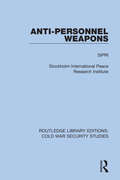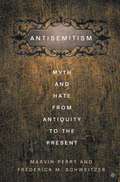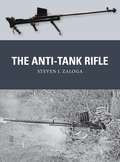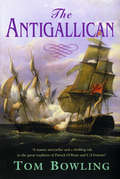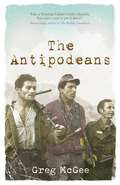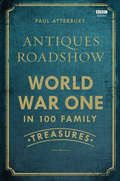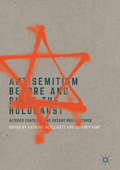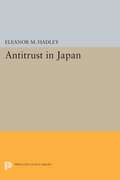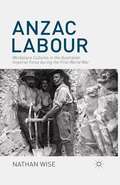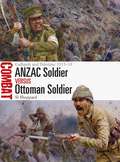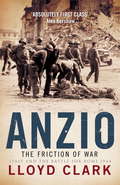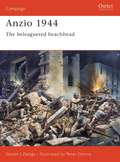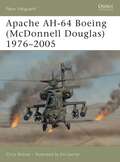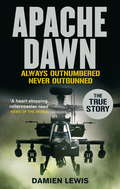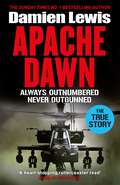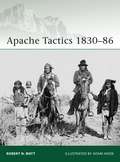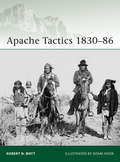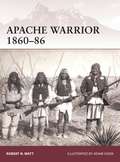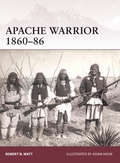- Table View
- List View
Anti-personnel Weapons (Routledge Library Editions: Cold War Security Studies #3)
by SipriThis book, first published in 1978, analyses the development, uses and effects of conventional anti-personnel weapons such as rifles and machine guns, grenades, bombs, shells and mines. It provides the historical, military, technical and clinical background to the international legal discussions as part of the ongoing efforts to prohibit or restrict the uses of some of the more inhumane and indiscriminate of these weapons, the most successful being the 1997 Ottawa Treaty that banned the use of anti-personnel mines.
Anti-personnel Weapons (Routledge Library Editions: Cold War Security Studies #3)
by SipriThis book, first published in 1978, analyses the development, uses and effects of conventional anti-personnel weapons such as rifles and machine guns, grenades, bombs, shells and mines. It provides the historical, military, technical and clinical background to the international legal discussions as part of the ongoing efforts to prohibit or restrict the uses of some of the more inhumane and indiscriminate of these weapons, the most successful being the 1997 Ottawa Treaty that banned the use of anti-personnel mines.
Anti-Semitism: Myth and Hate from Antiquity to the Present
by F. Schweitzer M. PerryIn this provocative book, Marvin Perry and Frederick M. Schweitzer analyze the lies, misperceptions, and myths about Jews and Judaism that anti-semites have propagated throughout the centuries. Beginning with antiquity, and continuing into the present day, the authors explore the irrational fabrications that have led to numerous acts of violence and hatred against Jews. The book examines ancient and medieval myths central to the history of anti-semitism: Jews as 'Christ-killers', instruments of Satan, and ritual murderers of Christian children. It also explores the scapegoating of Jews in the modern world as conspirators bent on world domination; extortionists who manufactured the Holocaust as a hoax designed to gain reparation payments from Germany; and the leaders of the slave trade that put Africa in chains. No other book has focused its attention exclusively on a thematic discussion of historic and contemporary anti-semitic myths, covering such an expansive scope of time, and allowing for such a painstaking level of exemplification. Anti-semitism is an essential book that will serve as a corrective to bigotry, stereotype, and historical distortion.
The Anti-Tank Rifle (Weapon)
by Steven J. Zaloga Johnny Shumate Alan GillilandThe emergence of the tank in World War I led to the development of the first infantry weapons to defend against tanks. Anti-tank rifles became commonplace in the inter-war years and in the early campaigns of World War II in Poland and the Battle of France, which saw renewed use in the form of the British .55in Boys anti-tank rifle - also used by the US Marine Corps in the Pacific. The French campaign made it clear that the day of the anti-tank rifle was ending due to the increasing thickness of tank armour.Nevertheless, anti-tank rifles continued to be used by the Soviets on the Eastern Front with two rifles, the 14.5mm PTRS and PTRD, and were still in widespread use in 1945. They served again with Korean and Chinese forces in the Korean War, and some have even appeared in Ukraine in 2014–15. Fully illustrated and drawing upon a range of sources, this is the absorbing story of the anti-tank rifle, the infantryman's anti-armour weapon during the world wars.
The Anti-Tank Rifle (Weapon)
by Steven J. Zaloga Johnny Shumate Alan GillilandThe emergence of the tank in World War I led to the development of the first infantry weapons to defend against tanks. Anti-tank rifles became commonplace in the inter-war years and in the early campaigns of World War II in Poland and the Battle of France, which saw renewed use in the form of the British .55in Boys anti-tank rifle - also used by the US Marine Corps in the Pacific. The French campaign made it clear that the day of the anti-tank rifle was ending due to the increasing thickness of tank armour.Nevertheless, anti-tank rifles continued to be used by the Soviets on the Eastern Front with two rifles, the 14.5mm PTRS and PTRD, and were still in widespread use in 1945. They served again with Korean and Chinese forces in the Korean War, and some have even appeared in Ukraine in 2014–15. Fully illustrated and drawing upon a range of sources, this is the absorbing story of the anti-tank rifle, the infantryman's anti-armour weapon during the world wars.
The Antigallican
by Tom BowlingMay 1794. France is starving and a giant fleet prepares to run Lord Howe's blockade to bring corn from America to France. One of the escorts - The Hortense - finds Jersey born fishing captain, Jean Cotterell, alone in the sea off the Grand Banks. His fishing vessel has sunk and he is the sole survivor.Life on The Hortense is like France under the Terror; chaotic, ungovernable, savage. Her captain, Dubarre, a former privateer, seems to despise his revolutionary crew as much as he hates the British. On the Glorious 1st June 1794 Hortense is intercepted by two British frigates which smash her. Her officers are dead, her crew decimated, and a storm is brewing. Only Cotterell has the skill to lead the frigate to port. But will he do it? The Antigallican is the first in a series of novels set at the end of the 18th century at sea, in Britain, in the Channel Islands and in Revolutionary France. In Jean Cotterell we find a character that bears comparison with Bernard Cornwell's Sharpe, in a narrative that will delight fans of Patrick O'Brian. 'With its captivating, pungent, and sharply drawn characters, this first instalment in a series of sea stories is a welcome addition to the Napoleonic sea story genre' - Margaret Barr - Historical Novels Review' believe [Tom Bowling] has a great future, and will become one of the leading authors in the historical naval fiction genre' - Robert Squarebriggs
The Antipodeans: A Novel (G - Reference, Information And Interdisciplinary Subjects Ser.)
by Greg McGeeThree Generations. Two Continents. One Forgotten Secret.2014Clare and her father travel to Venice from New Zealand. She is fleeing a broken marriage, he is in failing health and wants to return one last time to the place where, as a young man, he spent happy years as a rugby player and coach. While exploring Venice, Clare discovers there is more to her father’s motives for returning than she realised and time may be running out for him to put old demons to rest.1942Joe and Harry, two Kiwi POWs in Italy, manage to escape their captors, largely due to the help of a sympathetic Italian family who shelter them on their farm. Soon they are fighting alongside the partisans in the mountains, but both men have formed a bond with Donatella, the daughter of the family, a bond that will have dramatic repercussions decades later.The Antipodeans is a novel of epic proportions where families from opposite ends of the earth discover a legacy of love and blood and betrayal.'Like a Venetian Captain Corelli’s Mandolin. You won’t want to put it down.' – Simon Edge, author of The Hopkins Conundrum ‘Hugely evocative’ – Sarah Franklin, author of Shelter
The Antique Dealer’s Daughter
by Lorna Gray‘An original, authentic period mystery that keeps you guessing, with a strong female protagonist’ Jane Hunt Book Reviews
Antiques Roadshow: World War One In 100 Family Treasures
by Paul AtterburyTo mark the centenary of the start of World War I, the Antiques Roadshow team filmed a series of specials at the Somme, where the public brought in their family's war memorabilia and photographs. These 'antiques' weren't financially valuable, or in some cases even very beautiful, but the stories that came attached to these momentoes were priceless. Antiques Roadshow: World War I in 100 Family Treasures takes 100 of the most fascinating and moving stories and shows how they fit in to the wider history that was occuring around them. From Rifleman Frank Edwards, who led the 'big push' in September 1915 kicking a football in front of the troops (and survived to tell the tale) to the formidable Catherine Murray Roy, one of the first 50 nurses to be sent to the front lines in France. The story behind each object paints an intimate portrait of a long-lost relative, and quotes from the modern-day participants in the roadshow provide a moving link between the families then and now. Fully illustrated, and featuring all the stories from the show, this is a truly unique way of telling the story of those ordinary lives that were, by the onset of war in 1914, thrown into the most extraordinary of circumstances.
Antisemitism Before and Since the Holocaust: Altered Contexts and Recent Perspectives
by Anthony Mcelligott Jeffrey HerfDivided into five discrete sections, this book examines the issue of Holocaust denial, and in some cases "Holocaust inversion" in North America, Europe, and the Middle East and its relationship to the history of antisemitism before and since the Holocaust. It thus offers both a historical and contemporary perspective. This volume includes observations by leading scholars, delivering powerful, even controversial essays by scholars who are reporting from the ‘frontline.’ It offers a discussion on the relationship between Christianity and Islam, as well as the historical and contemporary issues of antisemitism in the USA, Europe, and the Middle East. This book explores how all of these issues contribute consciously or otherwise to contemporary antisemitism. The chapters of this volume do not necessarily provide a unity of argument – nor should they. Instead, they expose the plurality of positions within the academy and reflect the robust discussions that occur on the subject.
Antisemitism Before and Since the Holocaust: Altered Contexts and Recent Perspectives
by Anthony Mcelligott Jeffrey HerfDivided into five discrete sections, this book examines the issue of Holocaust denial, and in some cases "Holocaust inversion" in North America, Europe, and the Middle East and its relationship to the history of antisemitism before and since the Holocaust. It thus offers both a historical and contemporary perspective. This volume includes observations by leading scholars, delivering powerful, even controversial essays by scholars who are reporting from the ‘frontline.’ It offers a discussion on the relationship between Christianity and Islam, as well as the historical and contemporary issues of antisemitism in the USA, Europe, and the Middle East. This book explores how all of these issues contribute consciously or otherwise to contemporary antisemitism. The chapters of this volume do not necessarily provide a unity of argument – nor should they. Instead, they expose the plurality of positions within the academy and reflect the robust discussions that occur on the subject.
Antitrust in Japan (PDF)
by Eleanor M. HadleyBefore and during World War II, Japan's economy was controlled by power economic concentrations, large family holdings that passed from one generation to another, called zaibatsu. This book is a full assessment of the American postwar attempt to break up these powerful combines. Miss Hadley recounts both General Douglas MacArthur's efforts to implement the American occupation's antitrust policies and the Japanese government's resistance while it appeared to comply with zaibatsu dissolution. As the Cold War developed, American defense thinkers began to emphasize recovery rather than reform, and conservative American businessmen supported the abandonment of antitrust policy in Japan. The second half of the book examines the consequences of the antitrust measures and reaches conclusions which challenge prevailing Japanese and American views.Originally published in 1970.The Princeton Legacy Library uses the latest print-on-demand technology to again make available previously out-of-print books from the distinguished backlist of Princeton University Press. These editions preserve the original texts of these important books while presenting them in durable paperback and hardcover editions. The goal of the Princeton Legacy Library is to vastly increase access to the rich scholarly heritage found in the thousands of books published by Princeton University Press since its founding in 1905.
Anzac Labour: Workplace Cultures in the Australian Imperial Force during the First World War
by Nathan WiseAnzac Labour explores the horror, frustration and exhaustion surrounding working life in the Australian Imperial Force during the First World War. Based on letters and diaries of Australian soldiers, it traces the history of work and workplace cultures through Australia, the shores of Gallipoli, the fields of France and Belgium, and the Near East.
ANZAC Soldier vs Ottoman Soldier: Gallipoli and Palestine 1915–18 (Combat)
by Si SheppardIn 1915–18, ANZAC and Ottoman soldiers clashed on numerous battlefields, from Gallipoli to Jerusalem. This illustrated study investigates the two sides' fighting men.The Gallipoli campaign of 1915–16 pitched the Australian and New Zealand volunteers known as the ANZACs into a series of desperate battles with the Ottoman soldiers defending their homeland. In August 1915, the bitter struggle for the high ground known as Chunuk Bair saw the peak change hands as the Allies sought to overcome the stalemate that set in following the landings in April. The ANZACs also played a key part in the battle of Lone Pine, intended to divert Ottoman attention away from the bid to seize Chunuk Bair. The Gallipoli campaign ended in Allied evacuation in the opening days of 1916. Thereafter, many ANZAC units remained in the Middle East and played a decisive role in the Allies' hard-fought advance through Palestine that finally forced the Turks to the peace table. The fateful battle of Beersheba in October 1917 pitted Australian mounted infantry against Ottoman foot soldiers as the Allies moved on Jerusalem. In this book, noted military historian Si Sheppard examines the fighting men on both sides who fought at Lone Pine, Chunuk Bair and Beersheba. The authoritative text is supported by specially commissioned artwork and mapping plus carefully chosen archive photographs.
ANZAC Soldier vs Ottoman Soldier: Gallipoli and Palestine 1915–18 (Combat)
by Si SheppardIn 1915–18, ANZAC and Ottoman soldiers clashed on numerous battlefields, from Gallipoli to Jerusalem. This illustrated study investigates the two sides' fighting men.The Gallipoli campaign of 1915–16 pitched the Australian and New Zealand volunteers known as the ANZACs into a series of desperate battles with the Ottoman soldiers defending their homeland. In August 1915, the bitter struggle for the high ground known as Chunuk Bair saw the peak change hands as the Allies sought to overcome the stalemate that set in following the landings in April. The ANZACs also played a key part in the battle of Lone Pine, intended to divert Ottoman attention away from the bid to seize Chunuk Bair. The Gallipoli campaign ended in Allied evacuation in the opening days of 1916. Thereafter, many ANZAC units remained in the Middle East and played a decisive role in the Allies' hard-fought advance through Palestine that finally forced the Turks to the peace table. The fateful battle of Beersheba in October 1917 pitted Australian mounted infantry against Ottoman foot soldiers as the Allies moved on Jerusalem. In this book, noted military historian Si Sheppard examines the fighting men on both sides who fought at Lone Pine, Chunuk Bair and Beersheba. The authoritative text is supported by specially commissioned artwork and mapping plus carefully chosen archive photographs.
Anzio: The Friction Of War
by Lloyd ClarkThis is the story of the Anglo-American amphibious assault and subsequent battle on the Italian west coast at Anzio which was launched in January 1944 in a bold attempt to outflank the formidable German defences known as the 'Gustav Line'. ANZIO - THE FRICTION OF WAR outlines the strategic background to the offensive before detailing the landing, the development of an Allied defensive position, the battles in and around the perimeter, the stalemate, the breakout and the capture of Rome on 4 June 1944. While assessing the events at Anzio with the eye of an experienced military historian, Lloyd Clark also examines in detail the human response to the battle from high command to foot soldier. He also emphasises the German story - the first time this has ever been done.
Anzio 1944: The beleaguered beachhead (Campaign)
by Peter Dennis Steven J. ZalogaIn January 1944, the Allies decided to land at Anzio in order to overcome the stalemate at Cassino.This amphibious landing has become one of the most controversial campaigns of World War II. Questionable decisions by the Allied leadership led to three months of World War I-style trench warfare, and the entire beachhead suffered from continuous German observation and bombardment. Vividly describing each thrust and counter-thrust, this book takes us through the agonizing struggle as each side sought to retain or regain mastery. It shows how Anzio proved to be a stepping stone not only to Rome but also to the liberation of Italy.
Anzio 1944: The beleaguered beachhead (Campaign #155)
by Peter Dennis Steven J. ZalogaIn January 1944, the Allies decided to land at Anzio in order to overcome the stalemate at Cassino.This amphibious landing has become one of the most controversial campaigns of World War II. Questionable decisions by the Allied leadership led to three months of World War I-style trench warfare, and the entire beachhead suffered from continuous German observation and bombardment. Vividly describing each thrust and counter-thrust, this book takes us through the agonizing struggle as each side sought to retain or regain mastery. It shows how Anzio proved to be a stepping stone not only to Rome but also to the liberation of Italy.
Apache AH-64 Boeing (New Vanguard #111)
by Chris BishopThe Boeing (McDonnell Douglas, formerly Hughes) AH-64A Apache is the US Army's primary attack helicopter, and the most advanced helicopter gunship flying today. The most expensive rotary-winged aircraft ever built when it was introduced in the early 1980s, it has since proved its worth on battlefields all over the world, seeing action in the Gulf War, Afghanistan, Bosnia, Kosovo and the recent conflict in Iraq. This book examines the design, development and deployment of a quick-reacting, airborne weapons system that can fight close and deep to destroy, disrupt, or delay enemy forces.
Apache Dawn: Always outnumbered, never outgunned.
by Damien LewisThe Apache attack helicopter is the British Army's most awesome weapons system. Deployed for the first time in Afghanistan, it has already passed into legend. The only thing more incredible than the Apache itself are the pilots that fly her. For the first time, Apache Dawn tells their story - and their baptism of fire in the unforgiving battle of Helmand province. Their call-sign was 'Ugly' - and there was no better word for the gruelling 100-day deployment they endured. Day after day, four of the Army Air Corps' finest pilots flew right into the heart of the battle, testing their aircraft to the very limit. Apache Dawn takes the reader with them on a series of unrelenting and brutally intense combat missions, from daring, edge-of-the-seat rescues to dramatic close-air support in the white heat of battle.Bestselling author Damien Lewis has been given unprecedented access to these heroic aircrews and to the men on the ground whose lives they saved. It is an astounding story of bravery, skill and resilience in the face of unbelievable odds. And it is the story of the Apache itself - the ultimate fighting machine.
Apache Dawn: Always Outnumbered, Never Outgunned
by Damien Lewis'Damien Lewis is both a meticulous historian and a born storyteller' Lee ChildIn the summer of 2007 the British Army's 662 Squadron deployed its most potent weapons system in combat for the very first time - the iconic Apache attack helicopter. This is the definitive story of the aircraft and of the crew who fly her, and of their baptism of fire in the battle for Helmand Province, Afghanistan. Under the call-sign Ugly, four of the Army Air Corps' finest pilots flew a relentless series of missions during their 100-day deployment, stretching the aircraft, and themselves, to the limit. Apache Dawn recounts these operations from the perspective of the aircrew, plus the soldiers on the ground who owe their lives to the Apaches' intervention during the white-hot heat of battle. Bestselling author Damien Lewis has been given unprecedented access to the pilots of the Apache Attack Squadrons - an elite band of warriors operating at the very limits of modern warfare. Apache Dawn is their story, and it is one of untold bravery and resilience against all odds.'As good as any thriller I have ever read' Freddie Forsyth'Reveals a true story of British courage and daring' The Sunday Times'Riveting' Richard & Judy Show'The most dramatic story of a secret wartime mission ever' News of the World
Apache Tactics 1830–86 (Elite)
by Adam Hook Robert N. WattThe Apache culture of the latter half of the 19th century blended together the lifestyles of the Great Plains, Great Basin and the South-West, but it was their warfare that captured the imagination. This book reveals the skilful tactics of the Apache people as they raided and eluded the much larger and better-equipped US government forces. Drawing on primary research conducted in the deserts of New Mexico and Arizona, this book reveals the small-unit warfare of the Apache tribes as they attempted to preserve their freedom, and in particular the actions of the most famous member of the Apache tribes – Geronimo.
Apache Tactics 1830–86 (Elite #119)
by Mr Adam Hook Robert N. WattThe Apache culture of the latter half of the 19th century blended together the lifestyles of the Great Plains, Great Basin and the South-West, but it was their warfare that captured the imagination. This book reveals the skilful tactics of the Apache people as they raided and eluded the much larger and better-equipped US government forces. Drawing on primary research conducted in the deserts of New Mexico and Arizona, this book reveals the small-unit warfare of the Apache tribes as they attempted to preserve their freedom, and in particular the actions of the most famous member of the Apache tribes – Geronimo.
Apache Warrior 1860–86 (Warrior)
by Adam Hook Robert N. WattThe idea of an Apache warrior still evokes a stereotyped response; that of an elusive, cunning, ferocious and cruel fighter. Focusing on the Chiricahua Apache, led by such famous warriors as Cochise Mangas Coloradas, Victorio, Nana and Geronimo, this book explains how their upbringing, training and culture equipped them uniquely for survival in the harsh environment of New Mexico and Arizona, and enabled them to fight off their Mexican and American enemies for so long. Specially commissioned, full-colour illustrations featuring 'exploded' kit scenes and battle artwork complement meticulous research that seeks to strip away the myths behind the history of some of the most feared opponents of the US Army in the south-west United States.
Apache Warrior 1860–86 (Warrior)
by Mr Adam Hook Robert N. WattThe idea of an Apache warrior still evokes a stereotyped response; that of an elusive, cunning, ferocious and cruel fighter. Focusing on the Chiricahua Apache, led by such famous warriors as Cochise Mangas Coloradas, Victorio, Nana and Geronimo, this book explains how their upbringing, training and culture equipped them uniquely for survival in the harsh environment of New Mexico and Arizona, and enabled them to fight off their Mexican and American enemies for so long. Specially commissioned, full-colour illustrations featuring 'exploded' kit scenes and battle artwork complement meticulous research that seeks to strip away the myths behind the history of some of the most feared opponents of the US Army in the south-west United States.
